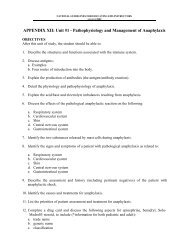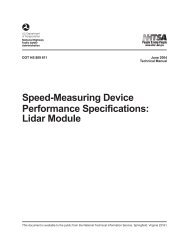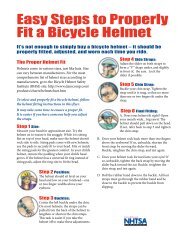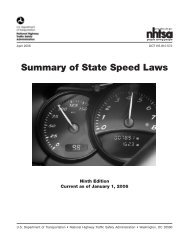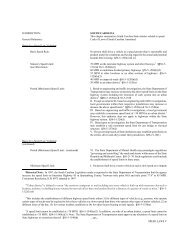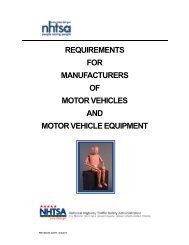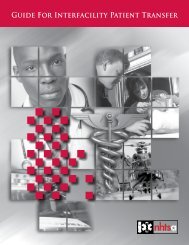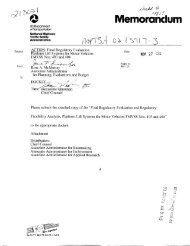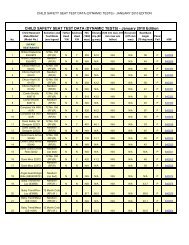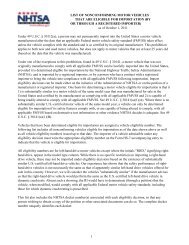Standard Practice for Emergency Medical Dispatch ... - NHTSA
Standard Practice for Emergency Medical Dispatch ... - NHTSA
Standard Practice for Emergency Medical Dispatch ... - NHTSA
You also want an ePaper? Increase the reach of your titles
YUMPU automatically turns print PDFs into web optimized ePapers that Google loves.
1. Compliance to asking the systematized interrogation questions. These<br />
should be subdivided to show different areas of interrogation in the<br />
EMDPRS.<br />
2. Compliance to providing the systematized pre-arrival instructions<br />
(when possible and appropriate to do so) should show separate<br />
compliance <strong>for</strong> each type of pre-arrival instructions found within the<br />
EMDPRS.<br />
3. Compliance to correctly selecting the dispatch response classification<br />
code.<br />
1. Records should be kept showing cumulative compliance scores in the<br />
listed areas <strong>for</strong> the following groups:<br />
1. Individual compliance averages;<br />
2. Shift compliance averages, and<br />
3. <strong>Emergency</strong> medical dispatch agency compliance averages.<br />
1. Group compliance averages should be periodically purged of older<br />
records allowing the EMD to reasonably improve scores over time,<br />
however, all records should be maintained and archived.<br />
1. The process of individual case review and their findings and<br />
recommendation should be managed by a specially trained diversified<br />
group of EMS and dispatch agency personnel. Participants in the<br />
management of the case review process should represent a crosssection<br />
of those individuals within the system affected by the<br />
emergency medical dispatch program. These should include, but not<br />
be limited to, line dispatchers, managers, administrators, medical<br />
control physicians or their representatives, or both, field personnel,<br />
and ancillary public safety groups such as 9-1-1, primary and<br />
secondary public safety answering points (PSAPs), that operate within<br />
the structure of an organized medical dispatch case review committee.<br />
2. The specific policies and procedures to be utilized <strong>for</strong> per<strong>for</strong>mance<br />
appraisal activity must be carefully explained to the EMDs whose<br />
per<strong>for</strong>mance will be measured and must be objectively and impartially<br />
administered.<br />
3. Regular feedback must be provided to the EMD based on the findings<br />
of their per<strong>for</strong>mance appraisal.<br />
4. The goal of the case review process is to enhance the per<strong>for</strong>mance of<br />
the EMD. This feedback should include both recognition of exemplary<br />
per<strong>for</strong>mance as well as behavior requiring remediation. This feedback<br />
must be provided in written <strong>for</strong>m and maintained in the employee's<br />
records.<br />
5. EMDs who consistently provide quality care should be recognized.<br />
Commendations, awards, advancements, media exposure, and other<br />
<strong>for</strong>ms of positive rein<strong>for</strong>cement are important elements of<br />
per<strong>for</strong>mance appraisal.<br />
6. The emphasis of any remedial activity should focus on re-training and<br />
modification of unacceptable practice patterns rather than on<br />
sanctions.<br />
1. Field-to-dispatch feedback mechanisms should be established to<br />
monitor, inquire about and document issues relative to the application<br />
of medical dispatch practices witnessed in the total system.<br />
67



